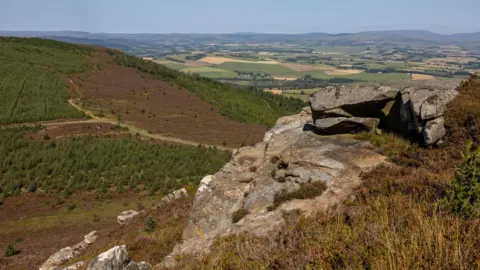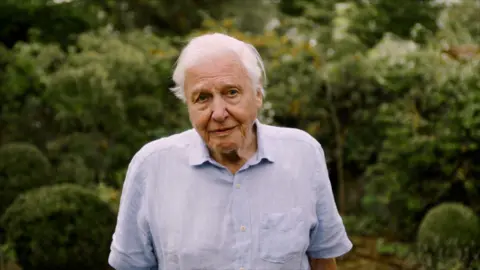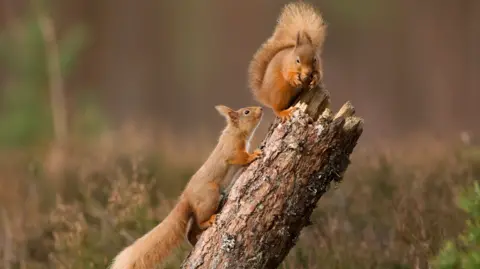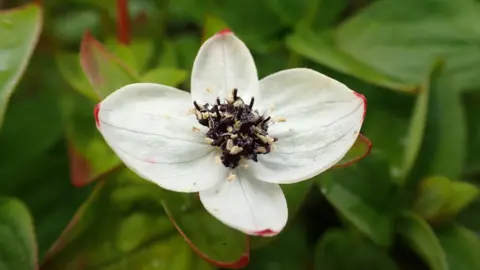Sir David Attenborough backs bid to buy Rothbury Estate

Evie LakeNorth East and Cumbria
 John Millard
John MillardSir David Attenborough has championed a bid by conservationists to raise £30m to buy the entirety of a vast upland estate.
The Wildlife Trusts and Northumberland Wildlife Trust are attempting to complete the purchase of the Rothbury Estate, a 15-sq-mile (30-sq-km) tract of former grouse moor, woodland and farmland, with plans to boost wildlife, restore bogs and promote nature-friendly farming.
With a year to go to raise the £30m needed to secure the entire estate, or risk it being broken up and sold off, Sir David has urged people to back the bid.
In a video, the naturalist and broadcaster said time was running out to save Rothbury Estate.
It is the largest area of land to be put on sale in England in decades and sits in the heart of what nature experts said could be a 40-mile (64km) “wild” corridor, stretching from the coast to Kielder and the Scottish border, and includes the Simonside Hills
Who owns Rothbury Estate?
Rothbury Estate was owned by the Duke of Northumberland’s youngest son, Lord Max Percy, and had been in the family for about 700 years.
The partnership between Northumberland Wildlife Trust and the Wildlife Trusts was given two years in October 2024 to raise the £30m needed to buy all of the estate.
 The Wildlife Trusts
The Wildlife TrustsSir David said: “People know and love the Simonside Hills that rise here, they walk the ridges and listen for the calls of the curlew, they watch for red squirrels and admire the views as they scramble among the crags.
“They walk along its remote paths and marvel at the astonishing rock carvings left by our distant ancestors, who once lived here.”
He said the Wildlife Trusts would work with local farmers and communities who lived and worked at Rothbury to care for the area, breathe new life into its habitats and create a place where people and nature could thrive side by side.
“Please help us make this vision a reality,” he added.
About £8m, in donations ranging from £5 to £5m, has already been raised, but the race is on to secure the remaining two thirds.
 Peter Cairns
Peter CairnsNorthumberland Wildlife Trust chief executive Mike Pratt said the purchase was a “once-in-a-lifetime opportunity” to do something meaningful for nature at a large scale through restoring and protecting habitat and increasing access to the countryside.
The estate is home to rare wildlife, including curlew, mountain bumblebees, lapwings, red squirrels, cuckoo and merlin, as well as Atlantic salmon and critically endangered eels, but the conservationists say nature could be richer still.
Their plans include bringing in large herbivores including ponies, hardy cattle and eventually even bison to graze the land naturally, and there are hopes pine martens, beavers and golden eagles could recolonise the landscape.
‘A great canvas’
Speaking to BBC Radio 4’s Today programme, Craig Bennett, CEO of the Wildlife Trusts said the Rothbury Estate was the biggest piece of land to come on the market in England for more than 30 years – and is larger than the city of York.
“That’s why it’s such a unique opportunity,” he said.
“We know that the UK is one of the most nature-depleted countries in the world and I’ve had enough in my lifetime of looking at lots of graphs that point nature going downwards.
“We want to bend the curve on that and start to bring nature back at scale.”
 The Wildlife Trust/PA
The Wildlife Trust/PAThe trusts said local people would benefit from greater access to the estate, with potential for building new paths, developing a visitor and education centre and creating new jobs.
Mr Pratt described the Rothbury Estate as sitting in an area which could be a “special area for nature recovery” – the only opportunity of that scale in England.
“It’s got a fantastic and interesting landscape already but when you look in detail a lot of the finer biodiversity, like everywhere else, is not there as it should be,” he said.
“It represents a great canvas to restore nature in that beautiful landscape.”




